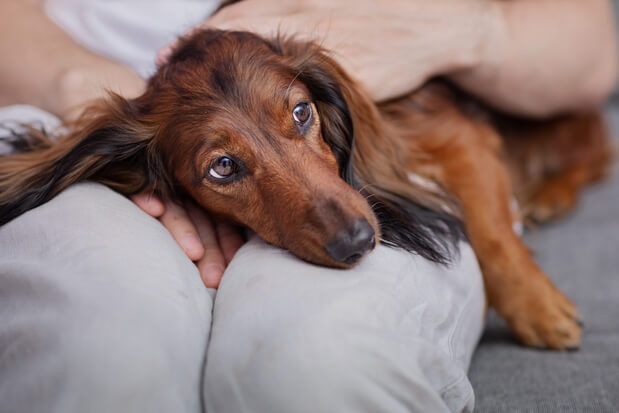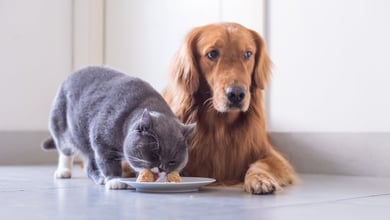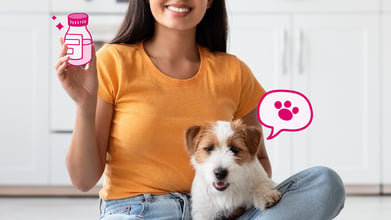How to Take Care of a Dog: 8 Vet-Recommended Tips

Table of Contents
As a responsible pet parent, ensuring your canine companion's well-being is key to fostering a long, healthy, and happy life for your beloved dog.
Proper dog care encompasses a range of essential aspects, including providing adequate nutrition, regular exercise, proper grooming, a comfortable living environment, regular veterinary check-ups, effective training, reliable identification, and safe handling practices.
By incorporating these eight fundamental elements into your dog's life, you can pave the way for many joyous years together, fostering a strong and loving bond with your furry best friend.
Get Your Pet’s Health Checked Out at Home
Say goodbye to stressful vet visits and hello to a comfortable wellness exam in your pet's favorite spot.
1. Feeding Your Dog
For a healthy, happy dog, proper nutrition and feeding are important. To meet your dog's energy requirements, purchase brand-name food with high-quality ingredients or make your own dog food that meets established nutrient profiles by the Association of American Feed Control Officials (AAFCO).
Dogs have different nutritional needs at different life stages:
- Puppies: Feed your puppy a well-balanced diet that has the proper nutrients to support a fast-growing puppy. Ensure you feed them three times a day. If you are unsure of the best puppy food for your dog's breed, consult your veterinarian.
- Adults: The type and amount of food your adult dog needs depends on their size and activity level. Different commercial diets can also offer different benefits, such as skin care or diets for sensitive stomachs.
- Seniors: A senior dog's diet may contain more high-quality proteins to fuel and maintain muscle mass but lower calories to account for less activity. It is important for a healthy balance of fat, proteins, sodium, and phosphorus. Some senior dogs may benefit from feeding them smaller portions more frequently throughout the day. This is also a good way to monitor their water intake in order to ensure proper hydration.
No matter your dog's age, avoid giving them potentially toxic foods like chocolate, raisins, or products that contain xylitol. You should also monitor their weight and tailor their portion size to maintain a healthy weight. Overfeeding is the leading cause of obesity in dogs, which can put your pet at risk of heart disease, arthritis, and diabetes, among other health issues.
Wash food and water dishes daily to prevent bacteria. You should add multiple water dishes in different locations throughout the house to ensure your dog has access to clean, fresh water at all times.
2. Exercise Needs
Pet parents should ensure their dogs exercise regularly, between 30 minutes and two hours daily. Play fetch, go for walks, make a dog obstacle course, and play indoor games for mental stimulation. Let them exercise more if you have active or working breeds, but less exercise will be ideal if you have for example, a toy breed.
Keep reading: The Physical and Mental Benefits of Exercise for Pets
3. Grooming Your Dog
Grooming your dog is an important part of how to take care of them. Here are our top grooming tips:
- Brush their fur to reduce shedding, remove dead skin, distribute its natural oils, and allow air circulation throughout the coat.
- Depending on their type of hair coat, bathe them on a regular basis to remove visible dirt, and keep them healthy and free from parasites.
- Brush their teeth to prevent oral problems.
- Trim their nails to prevent nails from growing back into the paw pads, causing pain and even making your dog limp. Nail trimming also protects your furniture and floors from dog scratches.
4. Providing a Safe Environment
A safe and comfortable environment prevents injuries and fosters emotional stability and positive behavior. Your duty as a pet parent is to provide lots of cozy dog bedding, adequate space, a secure environment free from threats, and a suitable temperature for your canine friend.
Dog bedding
Another way to care for dogs is to provide a comfortable bed in a warm, safe space to help them recharge from an eventful day and protect them from harsh weather, especially in colder seasons.
Take safety measures
Use a leash to keep your dog safe, and be considerate of other pet parents walking their pets around the neighborhood or in local parks. If you travel with your dog, use a seat belt attachment to secure them in the vehicle. Never leave them alone inside a car, as they can quickly die from heat stroke.
5. Regular Veterinary Checkups
Regular veterinary care visits help minimize the risk of serious complications, as they can help detect diseases and other issues early. Vaccinations safeguard your dog against contagious and potentially life-threatening diseases and boost their immunity. Daily teeth cleaning will limit the risk of mouth issues as your dog ages, and your veterinarian can perform more comprehensive dental care if necessary.
Arrange to have your female dogs spayed and male dogs neutered to prevent accidental breeding and prevent diseases that can affect their reproductive organs, such as testicular cancer.
Ensure you know how to contact your veterinarian in an emergency, even outside of normal clinic hours. If your pet has an accident, gets injured, eats something that might be toxic, or develops a rapid illness like vomiting and diarrhea, you will need to seek immediate veterinary care for them.
You can also get pet insurance to help pay for your dog's health and treatment if they are injured or need medical care.
Should My Pet Be Seen by a Veterinarian?
1. Have you noticed changes in your pet’s appetite?
2. Does your pet have diarrhea or loose stools?
3. Have you noticed changes in your pet’s thirst/water consumption?
4. Is your pet having accidents in the house?
5. Is your pet pacing and unable to settle?
6. Is your pet panting more than usual?
7. Is your pet whining or vocalizing more than usual?
8. Is your pet shaking more than usual?
9. Is your pet hiding or avoiding physical contact more than usual?
10. Is your pet more lethargic and sleeping more than usual?
11. Are you concerned about changes in your pet’s behavior?
12. Is your pet scratching their ears?
13. Is your pet licking their paws more than usual?
14. Does your pet have a rash?
15. Is your pet moving more slowly than usual or having a harder time getting up or down?
View Results
Should My Pet Be Seen by a Veterinarian?
1. Have you noticed changes in your pet’s appetite?
2. Does your pet have diarrhea or loose stools?
3. Have you noticed changes in your pet’s thirst/water consumption?
4. Is your pet having accidents in the house?
5. Is your pet pacing and unable to settle?
6. Is your pet panting more than usual?
7. Is your pet whining or vocalizing more than usual?
8. Is your pet shaking more than usual?
9. Is your pet hiding or avoiding physical contact more than usual?
10. Is your pet more lethargic and sleeping more than usual?
11. Are you concerned about changes in your pet’s behavior?
12. Is your pet scratching their ears?
13. Is your pet licking their paws more than usual?
14. Does your pet have a rash?
15. Is your pet moving more slowly than usual or having a harder time getting up or down?
Share Quiz
6. Training and Socialization
Training your canine companion encourages positive habits like obedience and proper manners. Crate training your puppy early will give them a safe space, as dogs love a quiet place to sleep and relax especially when you are away from home. Socialization with other dogs and people helps them become confident and adaptable.
To train and socialize your furry pet:
- Start early
- Use positive reinforcement training
- Offer dog treats to reward good behavior
Training and obedience are crucial for a well-behaved and happy dog, yet dog training needs patience and consistency.
Obedience training will help your furry friend know the rules to follow. Consult your veterinarian or a certified dog behavior consultant if you struggle to train your fur baby.
7. Identification and Licensing
In addition to a dog collar and leash, register your furry friend with the appropriate local animal control agency or municipal department so they're properly licensed. Veterinary clinics provide microchipping services to help reunite you with your canine friend if they get lost.
8. Safe Handling of Your Dog
Respectful and gentle handling fosters trust and a positive bond between you and your dog. Always treat your dog with kindness, patience, and understanding; they will respond with love and loyalty.
Tips for safely handling your dog:
- Approach them calmly
- Avoid rough play
- Respect their personal space, i.e., when they retreat to their bed
- Read their body language to understand them
- Supervise when children or new friends play with your dog
Conclusion
Taking care of a dog is a responsibility that comes with the rewards of love and companionship. Remember to prioritize their well-being through proper care, regular veterinary checkups, and professional advice to ensure a happy and healthy life for your furry companion.
Frequently Asked Questions
Are dogs easy to take care of?
Caring for a dog is a lifetime commitment that requires time, effort, dedication, and constant health monitoring.
How often should I feed my dog, and what should I feed them?
Puppies generally require more frequent meals (3–4 times a day), adult dogs typically eat twice daily, and seniors require smaller portions more frequently.
How can I ensure my dog gets enough exercise and mental stimulation?
Regular exercise and physical activity like daily walks, play sessions, and interactive games like fetch are essential for a dog's mental stimulation and enrichment.
What are the recommended vaccinations and preventive treatments for dogs?
Standard vaccinations include rabies, distemper, parvovirus, adenovirus-2, parainfluenza, and bacterial vaccine against Lyme disease and Leptospirosis.
How can I create a safe and comfortable environment for my dog at home?
Your home should be free from hazards and toxic substances. Provide a cozy bed, maintain a suitable room temperature, and keep your dog's living space clean.






